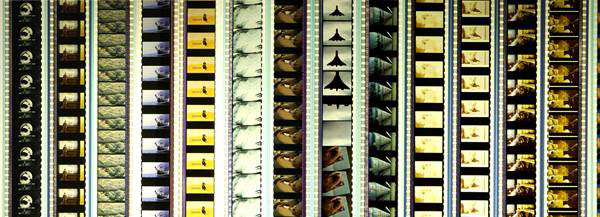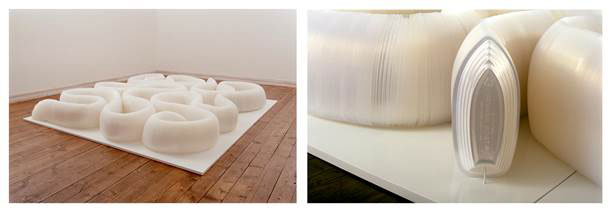The National Museum, Oslo Norway
Lucie Noel Thune’s sculptural installations are based on objects and materials of everyday life. These may include organic materials such as the wall sculpture From Nothing to Nothing which is configured in a clever system where eggs and metal wire are connected to each other. Primarily she makes use of industrial, mass-produced articles, such as banana split serving containers from a fast food restaurant. The works have strength in the tension from the consumer article to esthetic objects with creation of new meaning.
In the installation Coil, Thune uses movie films as raw materials. Each sculpture consists of one movie. At a distance, they remind you of a wavy mountain ridge landscape, which has finely tuned nuances between black, dark blue and green. When viewing closely, we get the impression of being pulled along in a vortex by the spiral line in the upper edge of the films.

Thune uses Norwegian and English movies that are well known to the public, all of which have been shown in theaters in the western world over the past years. What movie it is, is unimportant. It is the relationship between the private and collective memories that is of interest to Thune. She has assembled clips from many different films into collages as in pictograms consisting of five light boxes. In this way new stories are created and this is how she reinforces the fictitious character of the films. Thune also actively involves the public in the creation of story telling. On the light boxes the public may use magnifying glasses to study each frame on the filmstrip. In this way, the viewers can create their own new narrative.

It is fascinating how Lucie Noel Thune can transform everyday artifacts with no obvious esthetic importance into objects of high artistic quality. Thune has a special feeling for choosing materials and knows how to utilize their potentials. She is very attentive to how the light plays a significant role when viewing the work. In the installation Vermicular Banana Boats, she has used transparent banana split dishes as the basic material. In the assembly of 13,500 dishes we no longer get the impression of the material as transparent; it assumes a saturated, milky-white coloring. In more detailed studies we see how Thune has transformed the edges of the plastic dishes into a jagged transparent surface. The sculpture is configured as a long bulging shape squeezed together on a white square and gives us associations in several directions, from intestines to gigantic caterpillars.

From a detailed examination and adaptation of the basic material, Thune gives the original function of the objects a new life. She presents the commonplace, which is collective experience, and brings it forth to a new level giving it expanded function and meaning.
Eva Klerck Gange. Curator, Collection and Exposition at the National Museum for Art, Architecture and Design. Oslo, Norway.
